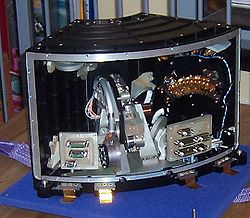- Infrared Space Observatory
-
ISO (télescope spatial)
ISO Caractéristiques Organisation ESA Domaine Télescope spatial dans l’infrarouge moyen et lointain Masse 1 800 kg Lancement 17 novembre 1995 à 01:20 UTC Lanceur Ariane 2 Fin de mission Mai 1998 Durée 28 mois Durée de vie {{{durée de vie}}} Désorbitage {{{désorbitage}}} Autres noms Infrared Space Observatory Programme {{{programme}}} Index NSSDC 1995-062A Site www.iso.vilspa.esa.es Orbite Orbite géosynchrone Périapside 1 000 km Périgée {{{périgée}}} Apoapside 70 500 km Apogée {{{apogée}}} Altitude {{{altitude}}} Localisation {{{localisation}}} Période 1 440 min Inclinaison 5,25° Excentricité {{{excentricité}}} Demi-grand axe {{{demi-grand axe}}} Orbites {{{orbites}}} Type {{{télescope_type}}} Diamètre {{{télescope_diamètre}}} Superficie {{{télescope_superficie}}} Focale {{{télescope_focale}}} Champ {{{télescope_champ}}} Longueur d'onde {{{télescope_longueur_d'onde}}} Instruments CAM 2 caméras infrarouge proche et moyen PHOT/PHT Spectromètre 5-210 µm SWS Spectrographe 5-35 µm LWS Spectrographe 35-205 µm {{{instrument5_nom}}} {{{instrument5_type}}} {{{instrument6_nom}}} {{{instrument6_type}}} {{{instrument7_nom}}} {{{instrument7_type}}} {{{instrument8_nom}}} {{{instrument8_type}}} {{{instrument9_nom}}} {{{instrument9_type}}} {{{instrument10_nom}}} {{{instrument10_type}}} {{{instrument11_nom}}} {{{instrument11_type}}} {{{instrument12_nom}}} {{{instrument12_type}}} Le télescope spatial ISO (pour Infrared Space Observatory) fut envoyé par l’ESA en 1995. Sa durée de vie fut de 28 mois. Son but scientifique était de faire des observations astronomiques dans les domaines de l’infrarouge moyen et lointain, entre 2 et 200 µm.
Les deux classes privilégiées d’objets observés avec cet instrument auront été les galaxies infrarouges distantes et les nuages moléculaires, comme rho-Ophiuchus ou les nébuleuses d’Orion.
Ce télescope constitue en fait le premier satellite IR pointé, successeur d’IRAS, satellite ayant fait une observation complète du ciel par balayage (survey) dans plusieurs bandes infrarouges.
Sommaire
Caractéristiques
Le miroir d’ISO mesure 70 centimètres de diamètre et quatre groupes d’instruments sont à bord :
- CAM deux caméras (chacune de 32x32 pixels) dans l’infrarouge proche et moyen, avec des roues à filtre
(SW-CAM couvre la gamme 2 à 6 µm, LW-CAM la gamme 5 à 15 µm);
- PHOT (ou PHT) des spectromètres/imageurs couvrant une large gamme spectrale de 5 à 210 µm ;
- SWS un spectrographe dans la gamme 5 à 35 µm ;
- LWS un spectrographe dans la gamme 35 à 205 µm.
Le satellite, réalisé par Aerospatiale au Centre spatial de Cannes Mandelieu[1], a continué à fonctionner aussi longtemps qu’il a disposé de réserves d’hélium liquide pour refroidir les instruments en dessous de -269°C. Après ce point, il n’a encore obtenu des résultats partiels que pendant 150 heures.
Successeurs d’ISO
Après ISO, d'autres télescopes spatiaux IR sont lancés:
- Wire (USA, échec du lancement en 1999)
- Spitzer (USA, lancé en 2003)
- ASTRO-F (Japon, lancé début 2006)
- Herschel (Europe, lancé en mai 2009, conjointement à Planck).
Notes et références de l’article
- ↑ Guy Lebègue, « Cannes : de Météosat à ISO », dans Revue aerospatiale, n°69, juin 1990
Voir aussi
Bibliographie
- Guy Lebègue, « ISO : Capter l’invisible », dans Revue aerospatiale, n°118, mai 1995.
- Guy Lebègue, « ISO : avant tout un formidable télescope », dans Revue aerospatiale, n°123, novembre 1995.
- Jean-Louis Heudier, « Etudes en rouge : de Newton à ISO », dans Revue aerospatiale, n°123, novembre 1995.
Liens internes
Articles connexes
- Liste des observatoires astronomiques
- Télescope spatial Herschel, successeur d'ISO.
- Centre spatial de Cannes Mandelieu
Liens et documents externes
- Portail de l’astronomie
- Portail de l’astronautique
Catégories : Observatoire spatial infrarouge | Agence spatiale européenne | Satellite scientifique
Wikimedia Foundation. 2010.

